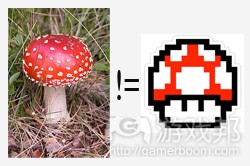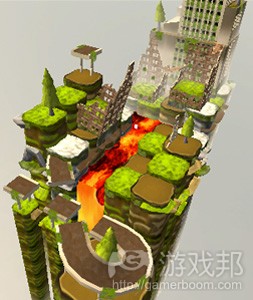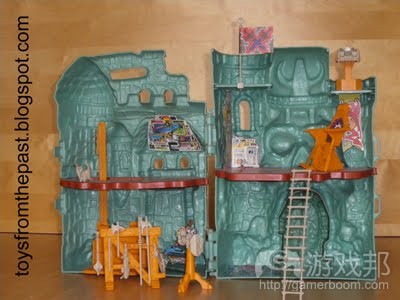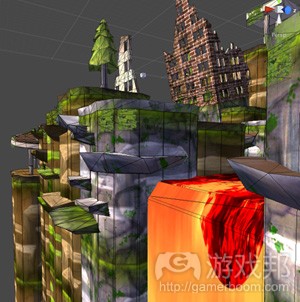长文,从环境拟真与道具设定角度谈关卡设定
作者:Matthew Hodge
在本系列文章的第一部分中,我将详细阐述塑造关卡环境的过程。在此我们便能够将内心对于游戏的愿景清晰地呈现出来,并确保这些环境足够特别且能够让人感到愉悦。

level design part 1(from gamasutra)
在现实世界中,自然风景并不是因任何挑战或娱乐目的而存在。瀑布旁边的石坡并不是为了帮助人们渡河才出现的。现实世界的风景固然美丽,但是它却不是为了让人们在此冒险 而形成。这里充满着各种难以通过的险境和死角。尽管分布着许多蘑菇,但是这种分布却不具备任何策略性或者也不如玩家期待的那样能够促成能量升级。

蘑菇(from gamaustra)
而在游戏世界中,环境的最大利益并不只是在玩家爬山1个小时候提供一些有趣的啤酒花,并钻到被伐掉的树下这样简单。游戏环境真正需要做的是在玩家游戏的沿途中创造出更多 有趣且具有挑战性的障碍。
当我在“The Legend of Sky”创造关于关卡设计的理念时,我遇到了一个问题,即难以平衡游戏外观、感觉与有趣且具有直觉性的布局之间的关系。但是当我开始将环境当成角色 来看待时,所有的障碍便瞬间瓦解了。
我列出了所有环境普遍存在的一些角色特征,以及一些独特的环境角色特征:
普遍的环境角色特征:
*玩家的导师
*忠诚
独特的环境角色特征:
*背景故事
*性别
*服装
这些设计要点都是面向于平台关卡而言,但是它们大多数都能够适用于各类游戏。让我们以《TLoS》为例,我将详细阐述这些要点是如何应用于概念关卡“被遗忘的悬崖”中。
环境中的智慧(玩家与导师间的关系)
说到导师时,我们总会立刻联想到老师。而在这里老师却不是出于教学目的而存在。它们将丢给你重重障碍,通过各种轻蔑的言论去激励你。通过这种特殊的方法,它们将为你指 出你所需要的策略,并帮助你克服它们所设立的挑战。不管是在何种情况中你都需要努力学习一些有价值的技能,以此帮助你更好地理解并克服生活中的挑战。
这便是一个优秀的游戏关卡所具有的特性。尽管游戏挑战设计不能有效地推动玩家前行,但是通过游戏的特别视角,巧妙的对象设置以及玩家在之前所体验到的挑战,它们便能够 明确穿越游戏的有效策略。游戏环境正是通过呈现出各种障碍和解决方法而扮演着玩家导师的角色。
忠诚的环境
环境要不就得支持玩家或敌人,要不就得同时放弃它们。这就意味玩家是受到挑战还是获得帮助要取决于其所处的背景环境。如果环境设立在敌人的主场中,玩家便会面临更多挑 战而获得更少的帮助;反之亦然。而如果环境处于中立领域(游戏邦注:即环境既非玩家的领地也不是敌人的领地),那么挑战和帮助便会趋于中和状态。

超级马里奥(from gamaustra)
我们能够在大多数《马里奥》游戏中看到这种忠诚理念。例如在《超级马里奥64》中游戏是围绕着城堡展开。虽然这里也存在各种挑战,但是玩家却可以轻松地解决它们。但是当 玩家沿着城堡往地牢前行时,挑战的难度系数也会随之升高。因为不管地牢是属于哪一方,它都不可能表现出“友好”或“善意”。
然后我们便能够穿过墙上的图像到达一些经典的关卡。这些关卡都比城堡世界更具有挑战性——就像Bowser关卡那样。Bowser关卡发生在敌人的领地,所以比起其它普通的关卡( 不带忠诚性),这里的环境和障碍会让玩家感到更加沮丧;但是如果玩家记得他们在之前环境中所学习到的,它们便会采取有效的策略去对抗敌方领地所存在的种种不利因素。在 这种环境下,游戏的进展速度非常快且充满紧张感。并且在这些关卡中玩家将找到并采用自己的获胜策略,而不非受到游戏的引导。
环境中的背景
我们有必要抽出一些时间仔细想想如何才能真正创造出关卡中的环境。这同时也能推动着我们思考应该呈现何种挑战以及它能够带给玩家何种感觉。
在我设计的关卡“被遗忘的悬崖”中,其背景故事便是源于地理上的变动。《TLoS》世界的形成是源于未来所发生的灾难。在经历了一系列情境后,我们的游戏世界平面发生了变 化,并与另一个现实合并在一起。尽管我们所了解的大多数世界都是沉入到“大地”之下,但是“被遗忘的悬崖”却是火山向上喷发所形成的,这也是玩家通往新世界的入口。

forgotten Cliffs(from gamasutra)
根据这一背景故事我们便能更好地明确游戏的图像风格,以及呈现在玩家面前的障碍类型。如果缺少了合适的故事背景,我们便会觉得关卡环境是没有意义的。我们应该让游戏环 境能够通过障碍和地理功能去传达目的,并最终引导着玩家进一步沉浸于游戏中。
它是男孩还是女孩?
在图像设计中,我们总是会将拥有锋利外表的对象判定为男孩,而将曲线柔和的视为女孩(以前的设计课程中老师持有这种观点)。但是今天的游戏世界中却出现了一种较为中立 的性别设计标准——并且也更加适合我们当前的例子。

魔兽世界关卡(from gamaustra)
让我们以《魔兽世界》中的环境设计为例子。当我们看到“荒地”时,我们自然会将这个充满锋利的悬崖峭壁的领域归为“男性”环境。而在暗夜精灵地区因为拥有许多连绵起伏 的群山,并且这种曲线的幅度显得较为柔和,所以我们会将其定义为“女性”环境。

gender Slider(from gamaustra)
据此我们可以勾勒出一个性别滑动器,并沿着一个斜坡从黑滑到白。如果我们将黑当成男孩,将白当成女孩,那么这个斜坡是否就意味着我们的级别下滑?其实与现实中的很多东 西一样,黑与白的真正价值很少能够明确地表现出来。而环境中的性别也是如此。尽管《魔兽世界》中的荒地充满悬崖峭壁,但是你同样也能够在这些悬崖找到柔和曲线的存在。
为了创造出具有独特且让人印象深刻的关卡环境体验,我不仅需要明确关卡的性别,同时也需要呈现出它们的不同特性。如此我才能更好地塑造出定义元素以及环境中所支持的各 种功能。
“要穿些什么?”
行头便是我的“环境角色”列表中的最后一个项目。这包括环境中的纹理和外围结构/道具。在我自己的关卡中,背景故事象征着过去的世界,男性环境也是就活跃的火山活动而造 就的悬崖峭壁而言。所以我们可以将这一关卡的个性总结为是一个愤怒的男人努力压抑自己对于这个世界的怒气。而这样的人应该穿些什么样的衣服呢?
原来的悬崖峭壁和肮脏的地面将会随着火山的平息慢慢被绿色植被所覆盖。长长的火山岩浆穿越于此,趟过岩石的边缘,就像是腰带一般。而残骸和遗迹更可当成过去世界所赠予 的装饰。
我们先稍停片刻,思考下我们现实世界的结构。假设我前往政府大楼,我位于第3层,现在我需要到隔壁楼的第2层去。我走过门廊,看到电梯位置的指示牌。于是,我大步走向公 用电梯,下到底层。现在,我可以走出这栋大楼。
现实世界的生活真是无聊!
之前,我们探讨了可用于将独特和有趣环境概念化的技术,但是现在我们面临的是比较不具理论化的任务。到了该真正构建关卡的时候了。我们需要考虑每个对象,思考应当将其 放在何处,以及如此放置的原因。
你的核心游戏机制是保证关卡有趣的元素。带着这种想法,我觉得最好的方式是罗列出关卡中你想让玩家进入的区域。随后,我只需要构建这些区域以及连接路径即可。对于我的 平台游戏而言,我构建路径和区域的首要目标是在核心游戏机制下显得有趣,其次是让环境带有现实主义感。通常情况下,最终产品的布局与现实世界有所不同。想法在于,当玩 家享受游戏体验时,他们的想象力能够填补我删减现实性的空缺部分。
那么,我们需要制作何种元素?何种元素应当具有互动性?要回答这个问题,我们要仔细研究Castle Grayskull、Cat’s Lair以及儿时的想象力。
Grayskull的设计

Grayskull(from gamasutra)
让我们看看以下设计点:
1、不要根据其他玩具进行缩放
2、缺少楼梯
3、每个可进入地点都有其作用
缩放很重要。如果一个人类与汽车相比时显得有12英尺高,就会让玩家产生怀疑。但是,我们可以设计某些对象大小比例不同的房间。游戏场景会修改缩放比,因为1:1看起来并不 实际。我会要求更多的空间,游戏中也是如此,尤其在快速式及手机游戏中。1:1的缩放意味着需要考虑更多的区域和空间。开发者需要做的事情更多,而且还可能减少产品对手机 玩家的价值,因为他们无法在很短的游戏时间内完成目标。所以,我们要如何在不产生明显视觉瑕疵的前提下影响缩放?
比如,平台游戏中的大建筑物可以被缩小,只要确保与玩家互动的建筑功能进行令人信服的缩放即可。如果门、窗户或楼梯等经过缩放处理,玩家很可能不会注意或在意这种情况 。建筑范围的减小有助于缩短角色花费在走路上的时间,使得需要开发和探索的区域较小,从而提升手机游戏的整体质量。
接下来,我们考虑缺少楼梯的设计。为什么玩具设计师不提供最实用的建筑结构用于实现楼层间的移动呢?显然是为了追求空间的最大化,但也是由于它们不是令人感兴趣的功能 。
如果功能无法令人产生兴趣,那它只是在浪费空间而已。这种去除无趣功能的原则需要根据你的游戏类型进行调整。如果你制作的是更具现实主义的游戏,可能需要考虑用有趣的 方法来整合人们在现实场景中能够看到的环境元素。
我想要阐述的最后一点是,角色能够到达的每个地点都有其存在的目的。当你看到楼层时,你就会注意到其中的电脑主机、宝座或活门。任何楼层或突起的存在都有其作用。这应 当成为我们关卡设计的主要关注点。以我的游戏为例,无意义的区域会让玩家感到愤怒。
想象下你正在玩一个游戏关卡。你一直往前走,每样东西看起来都很棒。转过某个角落后,你看到了另一个平台。你的第一感觉是,那里应该有些不错的东西,可以过去看看。不 幸的是,当你过去之后什么也没发现。这个平台的存在只是为了让场景从远距离看更加出众。但是,你之前根本不知道这点。你可能为了到达那个平台而花费了许多个生命,还没 有成功就已经感受到巨大的挫败感,甚至因此放弃游戏,抑或你成功地找到到达这个平台的方法。如果你成功到达此处,但很快意识到之前的努力毫无价值。这个关卡浪费了你很 多时间,更糟糕的是,没有提供回到原路径的方法。这样,玩家就只有两个选择,要么永远退出游戏,要么惋惜自己之前付出的努力。

fcplat(from gamasutra)
游戏中绝对不可以出现上述场景。作为关卡设计师,我们必须确保每个可到达的地方都能让玩家感受到好处。下面,我将讨论的是ThunderCat的Cat’s Lair中的游戏场景。
特殊道具设计
这个游戏场景提供了独特的有关玩具间互动的启示。
你会注意到,头的背后有个为动作角色准备的座位,带有扳机杆。Lair的头可以被旋转。扳机激活口中的红外传感器。隔层的主门上是个光传感器。当其他玩具的红外系统射入 Lair时,它能够监测到。当承受的伤害足够时,警报就会响起,门就会弹开。Lair的头带有激光防御。当它集中对手玩具上的传感器时,对方就会被破坏。

thunder cats(from gamasutra)
所以,Cat’s Lair和对手车辆可以向任何地方射击,但是只有在射向特定点时才能起到作用,这个点就是设计用来接收和响应射击的。
这是个很重要的可借鉴之处。如果在我们的关卡中设计武器或其他互动器具,我们要确保其有具体和特别的目的。这种目的应当能够帮助玩家享受游戏体验,有助于他们在游戏中 取得进展。
而且,根据你所制作游戏的不同,对于这项原则的使用也有所差异。比如,在现实主义射击游戏中,人们都希望自己仓库中的普通武器能够对游戏中的所有东西起作用。但是,即 便在这种题材中,也可以设置特殊环境武器只对某些特别元素起作用。比如,大型加农炮只能用来摧毁墙壁,以便让玩家通过。
关卡中玩家可以使用的道具应当清楚地标注出来,这一点也很重要。道具适用的地方以及使用方法也应当清晰说明。现在游戏普遍采用红色提示的方法,尽管这显得有些过时。在 我的游戏中,我承诺将对此进行革新。
于是,有个问题随之产生:最终让我们关卡有趣且前后一致的是什么?这种东西就是让我们孩童时觉得那些玩具有趣的东西。那就是我们的想象力。
孩提时代,当我们玩玩具时,每次的体验都有所不同。孩子们不会思考为何没有楼梯,他们可以直接从底层地下室跳上第2层的控制室。孩子的想象力无缝地填充了玩具中的现实性 缺失。
成人仍然具有孩子般的想象力,只是使用的频率有所减少。作为游戏设计师,我们需要向玩家做出承诺,我们将使用想象力来设计游戏。当我们感觉想法枯竭时,我推荐重新体验 孩童时玩过的玩具和游戏。让它们触发你的新想法。
如果我们的核心游戏机制有趣,环境设计与之相符,那么成人的想象力也会自动填补现实性的空缺。当这种情况发生时,玩家将从游戏体验中收获愉悦和快乐。
总结
环境并不需要同其现实世界形态保持一致。通过抽象和删减来呈现现实,我们可以为玩家营造更流畅和更丰富的体验。对于以玩法为中心的布局的设计,玩具时很好的灵感来源。
在本系列文章中,我已经讨论了自己概念化和物质化关卡的方法。在最后一部分的文章中,我将讨论关卡技术美术开发的想法和设计方法。我将继续以自己的游戏《The Legend of Sky》为例,使用Unity3D游戏引擎。下篇文章可能成为我们分享和讨论技术美术设计方法的绝佳起点。
相关拓展阅读:篇目1,篇目2(本文由游戏邦编译,转载请注明来源,或咨询微信zhengjintiao)
Level Design Part I: Personification (environments are characters too)
by Matthew Hodge
In this first of a three part post, I detail my process of characterizing a level’s environment. This is a great way to dial in a clear vision for a game, and ensure each environment is unique and entertaining.
In the real world (as we understand it to exist) natural landscapes are not formed for the purpose of providing a challenging and fun path to traverse. A rocky ledge beside a waterfall isn’t going to be perfectly positioned so that one can time a jump to land on debris that is flowing over the edge at regular intervals. It’s sad, I know. While beautiful, the real world just isn’t pieced together so that one can fluidly adventure through it. It’s full of unreasonably difficult locations and dead ends. While containing many mushrooms, they are not strategically placed or have quite the same power up effect as a knowledgeable gamer would expect.
In the game world, its not in an environment’s best interest to provide only a couple of fun hops followed by an hour of uphill walking, just to duck under a fallen tree. A game environment needs to provide enjoyable and challenging obstacles every step of the way.
When developing my concept for level design in “The Legend of Sky”, I ran into difficulty trying to balance a believable look and feel, with a layout that is both fun and intuitive. My designer’s block was finally broken when I decided to start looking at the environment as a character.
I listed out character traits that should be common to all environments, and those that are unique to each environment: Common environment character traits:
Mentor to player
Discernible allegiance
Unique environment character traits:
Back-story
Gender
Apparel
These design points are geared towards platforming levels; however, much of these principles can be applied to most types of games. Using TLoS as an example, I’ll walk through how each of these points has been applied to the conceptual level “The Forgotten Cliffs”.
Environment Wisdom (player mentor-ship)
When we think of a mentor, gear your thoughts towards a sensei. A sensei will seem adversarial for the purposes of teaching. They will throw obstacles at you. They often talk down to motivate you. Through all of this, they will point to the strategy you need, to overcome the challenges they’ve created. In each instance, you will have learned valuable skills that will help you to understand and overcome challenges throughout life.
This is how a good level will play. The challenges are designed to give the player a little struggle, but through the use of camera angles, clever object placement, and experience with previous challenges, a clear strategy is presented that guides the player through. With presentation of obstacles and solutions, the environment is designed to mentor the player along their way.
Environment Allegiance
The environment should side with either the player the enemies, or neither. What this means is that while challenging and assisting the player, the level of challenge and assistance should be skewed toward the level’s back-story. If an environment is the home ground of the enemy, the challenges should be hard and the assistance minimal, and vice versa. If the environment is an area that is home to neither, there should be a blend, or medium difficulty.
We see this concept of allegiance demonstrated in most Mario games. For instance, the home ground in Mario 64 is the castle that serves as the hub world. There are challenges presented, but they are typically easy to accomplish. The challenges can get a little more difficult as you venture below the castle into the dungeon. Dungeon’s, regardless of who they belong to, are designed to not be friendly.
Then we have the typical levels that are mostly reached via jumping into paintings on the wall. They are more challenging than the castle world, but not as much as the Bowser levels. The Bowser levels take place on the enemies home ground. The environment and obstacles can be downright frustrating when compared to the average (no allegiance) levels; however, if the player remembers everything the previous environments have taught them, then the player should be able to spot the strategy that even the enemy’s home ground is offering. In well designed enemy levels, it often doesn’t even feel that the strategy is offered. Everything happens faster and more intense. In these levels it should feel that the player found and took their winning strategy, as appose to having been guided to it.
Environment Back-story
It’s important to take time out and imagine what brought a level’s environment into existence. This will help in imaging what sort of challenges it will present, and it’s overall feel.
In the case of my level “The Forgotten Cliffs”, the back-story is one of geographic violence. The world of TLoS exists due to catastrophic events brought on by our near future modern society. Through a string of situations, our world shifted its plane of existence and merged with another reality. While most of the world as we know it was plunged below the Earth, the Forgotten Cliffs were the result of a volcanic upward thrust, that still exists as a vent for this new world.
This back-story has helped in determining visual style, and the types of obstacles to present the player with. Without a good back-story, a level’s environment can find itself suffering from meaninglessness. An environment should convey its purpose for existing through its obstacles and geographic features, which ultimately lead to better player immersion.
Is it a Boy, or Girl?
In graphic design it is taught that strait lines and sharp surfaces are masculine design qualities, while curved shapes are feminine; at least that was taught a decade ago when I had a design class. I suppose today’s world might throw in a gender neutral design standard – which would actually work well in this instance, because some levels work best with a design that is somewhere in between.
Looking to modern games as an example, let’s consider some of the environment designs in “World of WarCraft”. If we look at the Badlands, we see an area defined by sharp towing cliffs. This would be a more masculine environment. On the flip side, many of the night elf areas have rolling hills and structures with curves (note that the curves are often implied through textures).
It can help to picture a slider that slides a long a gradient from black to white. If we were to say Black is a boy, and white is a girl, where on this gradient would our level fall? As with most things in life, true black and white values seldom occur. This should also be true when thinking about our environment’s gender. Even with the example of the Badlands in WoW, you’ll notice that curves do occur at the base of the sharp cliffs and ridges.
In order to develop the level’s environment into a unique and memorable experience, I not only declare the level to be a boy or girl, but how masculine or feminine the level is. This will help to conceptualize the defining elements and upporting features of the environment.
“What to wear, what to wear?”
The final item on my “environment as a character” list, is wardrobe. This includes textures and peripheral structures/items that characterize the level. With my concept level, it’s back-story indicates that it represents a glimpse of the old world. It is masculine because of the violent, upward thrusting, volcanic activity that has forced sharp vertical cliffs. The personality of the level can be summarized as one angry dude that is trying to calm down as it reflects on the world that was. So what would someone like this wear?
It is draped in rocky cliffs, dirt ground, and green forestry that is slowly taking it over as it calms down. It has long flows of lava that vent through it and flow over the edges, almost as a sash. It is accessorized with debris and relics from the world past.
I’m still answering this question and it will probably be adjusted as the game moves forward; however, because I’ve designed so much of the environment’s character already, I have a clear direction to move in.
Part 1 Summary
By personifying our level and its environment, we can create a clear vision for each level to be unique, interesting, and to get the most enjoyment possible out of our ideas.
In part 2 of this 3 part series on level design, We’ll be looking at the purpose of everything. Every respect of the level should have a reason to exist for the player. It often helps if the level is abstract in layout. For examples I’ll reference toys and play sets, and how their designs can help us get in the right mindset for level development.
I’ll see you all at my next article. Thanks for reading
Let’s stop a moment to ponder the structure of our real world. On a trip to one of our government buildings. I was on the 3rd floor, and I needed to get to the 2nd floor of the building next door. I walked down a hall way with signs pointing me to the elevator. In a daring leap of faith, I rode that government elevator to the 1st floor. I could now exit the building… Actually this sucks.
Man, the real world is BOOOOOORRRING!
In part 1 we examined a technique for conceptualizing our unique and fun environments, but now we’re faced with a much less theoretical task. It’s time to actually build the level. We need to think about every object, where it is being placed, and why.
Your core game mechanics are what keeps it fun. With that in mind, I find it best to list the areas of a level that you want the player to access. I then only build those areas and the paths that connect them. For my platform game, the paths and areas I build are designed to be fun for my core game mechanics first, with realism to the environment second. The end product is typically a layout that wouldn’t make sense to the real world. The idea is that when they player is enjoying the experience, their imagination will fill in the gaps in my abridged version of reality.
So, what elements do we make, and what elements should be interactive? To answer this, we’ll examine “Castle Grayskull”, the “Cat’s Lair”, and our childhood imagination.
By the design of Grayskull!
Let’s take a look at the following design points:
Not to scale with other toys
Lack of stairs
Purpose for every accessible location
Scale is important. A human character that is twelve feet tall when compared to a car is going to introduce a dis-connect with the player; however, we can get some wiggle room with objects that are very different in size to begin with. Play sets change the scale because a 1:1 with the figures wouldn’t be practical. I would require too much space, and not be easily moved Oddly enough the reasons for a scale skewing in games is very similar, especially in quick-play/mobile games. 1:1 scale means more areas and space to be accounted for. This is more work for the developer, and potentially decreases value to mobile players by not allowing them to complete goals in short play sessions; so, how do we effect scale without causing on obvious visual flaw?
For an example, large buildings in a platform game can be shrunken down, as long as the features of the building that a player would interact with are convincingly scaled. If the doors, windows, stairs, etc. are to scale, it isn’t likely that one will notice or care that the square footage is off. This reduction of building scale would shorten the amount of time spent walking, create less areas that need to be developed, and be an overall benefit for mobile games.
Next, we”ll look at the lack of stairs. Why did the toy designer not provide the most practical structure for moving between floors? Space is the obvious answer, but they’re also not an exciting feature.
If the feature isn’t exciting, it’s just taking up space. This principle of ruling out un-interesting features needs to be adjusted with your type of game. If you’re going for realism, you’d probably need to think of an interesting way to incorporate environment pieces one would expect from a real location.
The last point I want to make about He-Man’s fortress, is that every location a figure can populate has a purpose. If you see a piece of floor, you’ll notice it’s associated with computer consoles, the throne, or the trap door. Up top we have a lookout position and defensive equipment. There isn’t any ledge/floor that exists just “because”. This should serve as a major design point for our levels. In the example of my game, meaningless areas can infuriate the player.
Imagine you are playing a level. You’re platforming along, and everything seems great. Then off on the corner of the screen you can see another edge. Your initial thought would likely be “hey, I wonder what’s over there. It’s got to be good”. Unfortunately for you, there is no reason to get over there. It was just put there because it made the scene look cool from a distance; however, you have no way of knowing that. You’ll likely spend a number of lives trying to get there before you get frustrated and give up (possibly on the entire game), or you’ll actually find a way to make it. If you do manage to get there, you’ll quickly realize that there isn’t anything to do or achieve. The level wasted your time, and worse, it didn’t provide a way back. Now you have to quit or die for all of your hard work.
The previous scenario is inexcusable. As level designers we must make sure that everything accessible exists for the player’s benefit. The next set of points I’d like to discuss are nicely illustrated by the ThunderCat’s Cat’s Lair play set.
“Special item design, snaaarrf.”
This play set offers unique lessons in interaction between the toys in the Thunder Cat’s line.
You’ll notice the back of the head has a seat for the action figure, with a trigger handle. The head of the lair can be rotated and aimed. The trigger activates an infrared sensor in the mouth. Above the layer’s main doors is a light senor. This detects when another toy’s infrared system has fired in the Lair’s line of site. When other toys fire directly at the sensor above the layer door, the lair records damage. When enough damage is taken, an alarm sounds and the doors pop open. The lair’s head is a laser defense. If it hits the sensor on the enemy toy, it will pop apart.
So, the Cat’s Lair and enemy vehicles can shoot where ever they want, but it only has an effect if they shoot the designated spot that is designed to receive and react to the shot.
This is an important take-a-way. If we design a weapon or other interactive piece to our level, let’s make sure it has a specific and special purpose. That purpose should help the player enjoy the experience and progress through the game.
Again, depending on the game you’re making, your exercise of this principle will vary. For instance, in a realistic shooter one would expect the average weapons in their inventory to gain some reaction from whatever they use it on; however, even this genre has instances of special environment weapons that only work on other specific elements. Such as a large cannon that only damages a specific wall to allow the player to progress.
It is also important that level items meant to be used by the player are clearly marked. It should also be clearly marked as to where and how it should be used. In games this most commonly occurs as “red barrels”; though that is getting old. For my game, I promise to come up with something besides red barrels.
Now the question, “What is it that ultimately makes our levels fun and coherent?” It is the same thing that made those toys fun when we we’re kids. It’s our imagination.
As kids play with toys, it is a fluid experience. They don’t think about the fact that there aren’t any stairs to climb, and that they just leaped from the first floor dungeon to the second floor control room. It’s a non-issue. A child’s imagination seamlessly fills in the gaps in reality as they play.
Adults still have that child-like imagination; it just doesn’t get used as often. As game designers, we need to make a commitment to our players that we will design our games using imagination. When we’re feeling dry, it’s my commendation to reflect and reconnect with the toys and games we played as kids. Let them refresh you.
If we make our core game mechanics fun, and the environment’s design plays well to it, an adult’s imagination will rekindle to fill in the gaps in reality. When this happens, the player will be enjoying the experience.
Part II Summary
Environments don’t need to be true to their real world counterparts. By making abstract and abridged versions of reality, we create a smoother and more imaginative experience for the player. Toys and play sets are great sources of inspiration for creating play-centric layouts.
In this series I’ve discussed my methods for conceptualizing, and materializing levels. In the final part of this three part series, I will discuss good practices and ideas for the technical art development of levels. I’ll focus on my game “The Legend of Sky” as an example, and I’ll be using the Unity3D game engine. This next post should be a great starting point for sharing and discussing technical art design practices we’ve picked up.







































 闽公网安备35020302001549号
闽公网安备35020302001549号